Skip over navigation

Richard, a teacher from Cliff Lane Primary School, sent in the following:
There are 28 triangles to be made.
My class started by drawing the triangles from one peg. There were 7 possible triangles connecting peg 1 and 2, keeping that first short line constant.
They then kept peg 1 the same and connected it to peg 3, keeping this constant. They were able to make triangles using pegs 4, 5, 6, 7, 8 and 9. This results in 6 possible triangles.
They repeated for a constant line from peg 1 to peg 4 and found 5 triangles. They recognised the following pattern:
Constant line
Peg 1 - 2 7 triangles
Peg 1 - 3. 6 triangles
Peg 1 - 4. 5 triangles
Peg 1 - 5. 4 triangles
Peg 1 - 6. 3 triangles
Peg 1 - 7. 2 triangles
Peg 1 - 8. 1 triangle
Peg 1 - 9. 0 triangles
They added these up and found 28 triangles. This could be repeated for each new peg, but the triangles would be repeated, so would not count in the final total.
The next two solutions looked at a way of getting all the triangles by getting a series of numbers connected to the 9 points.

This is a good idea, and, as so often happens in mathematics as well as helping, can produce a problem. So while 123,124,125,126,127,128,129, as a starting point is a good idea the problem arises when you go to ones starting with 234,235,236,237,238,239 it looks like we have made a further six but the size and shape of 123 is identical to 234. The same is true for the ones that would follow on. It's a matter of not losing sight of what the numbers are representing.
The next solutions did well to see that 123,321,213,312,231,132 are all the same.
Here is Tiffany's, then Claire's, work from Citipointe Christian College in Australia:
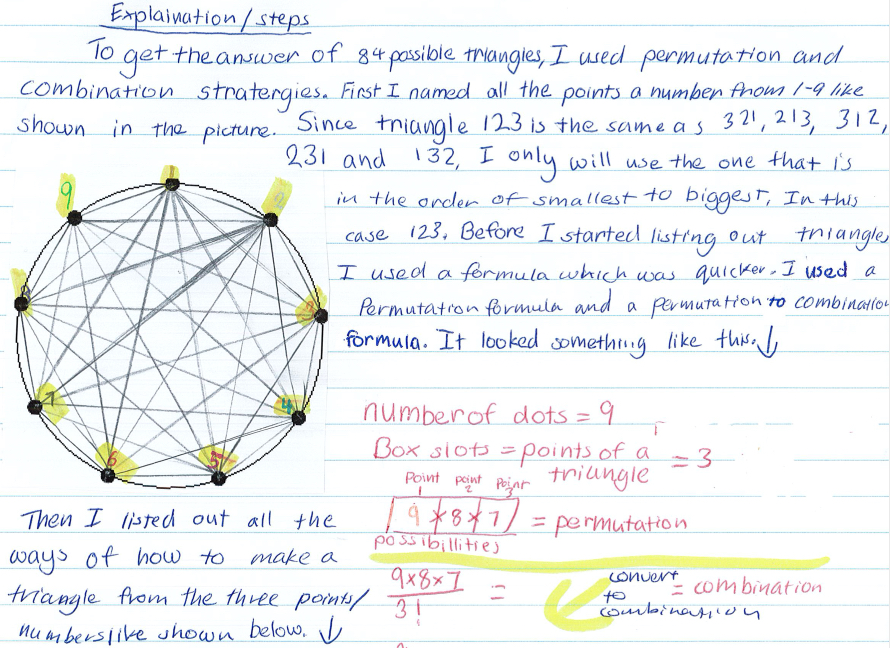

- - - - - -
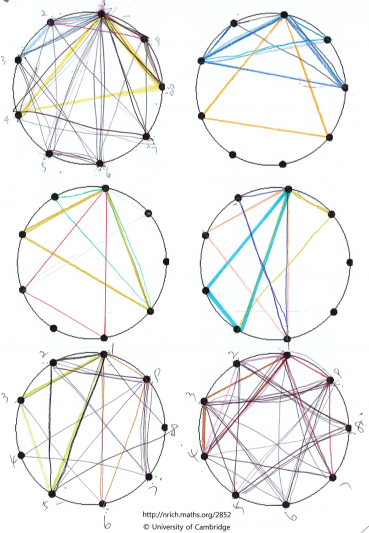
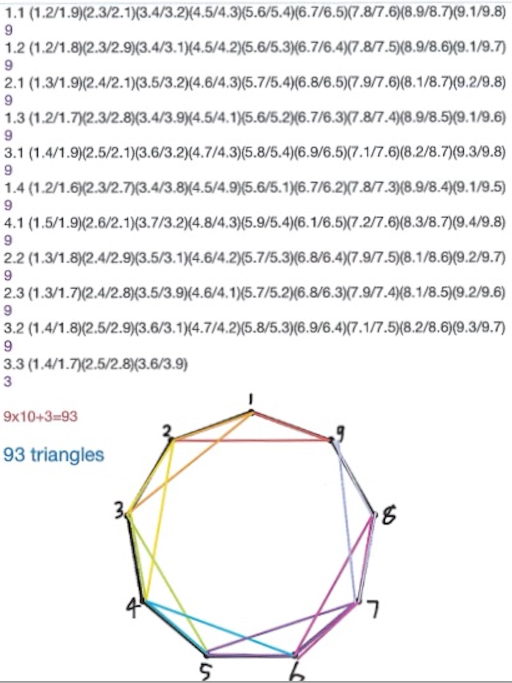
Jiwoo and Sushi then Harry, Judy and Mai from The British International School Ho Chi Minh City in Vietnam sent these in:
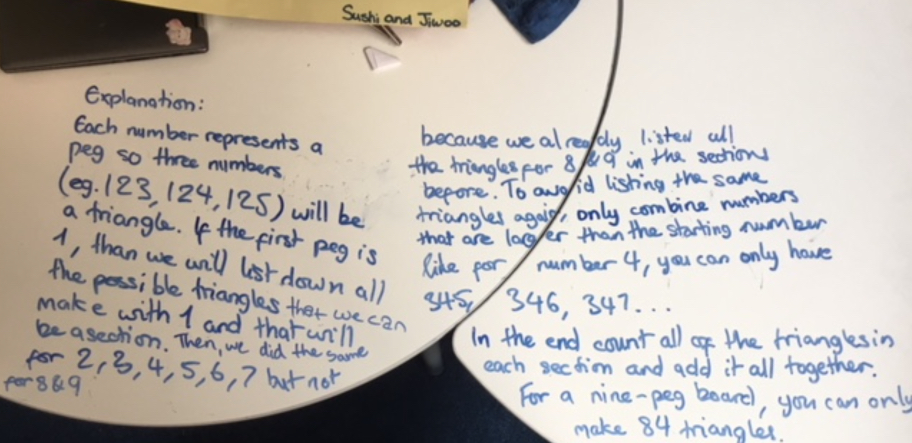
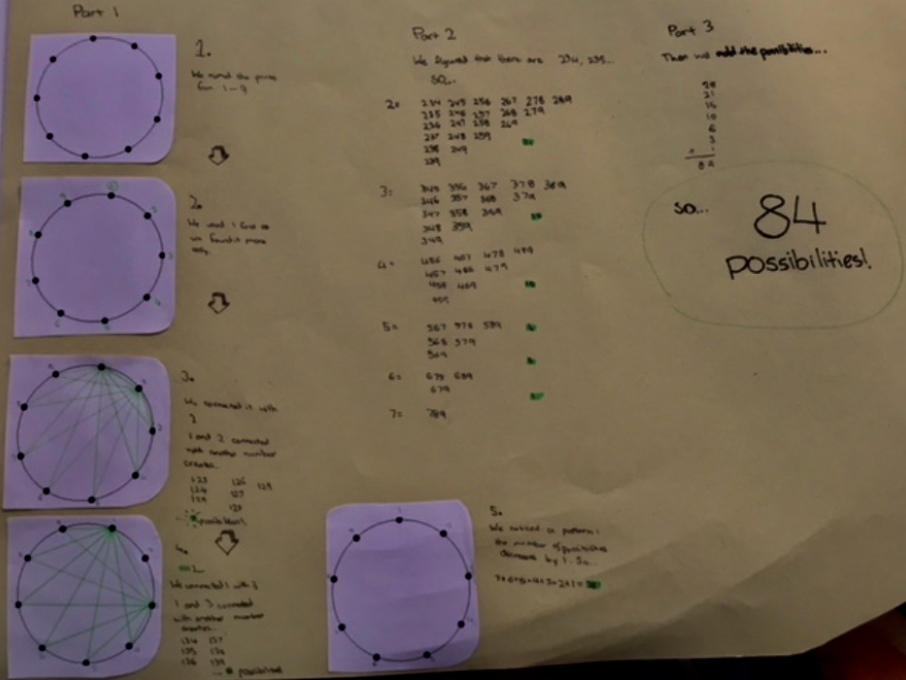
Thank you for these excellent thoughts and conclusions about this task, we hope to see you send in more solutions in the future.


Or search by topic
Number and algebra
Geometry and measure
Probability and statistics
Working mathematically
Advanced mathematics
For younger learners
Nine-pin Triangles
Age 7 to 11
Challenge Level 





- Problem
- Getting Started
- Student Solutions
- Teachers' Resources
Cong who goes to St. Peter's RC Primary, Aberdeen, sent in a good solution to this problem. The key to answering it is to be sure you know what you mean by "different" triangles. Cong found 7 different triangles could be drawn on the nine-pin board which he drew:

He also sent in a table which gave some more information about each triangle:
| Number | Colour | Type |
| 1 | Green | Isosceles |
| 2 | Light blue | Scalene |
| 3 | Purple | Scalene |
| 4 | Orange | Isosceles |
| 5 | Pink | Scalene |
| 6 | Blue | Isosceles |
| 7 | Red | Equilateral |
Richard, a teacher from Cliff Lane Primary School, sent in the following:
There are 28 triangles to be made.
My class started by drawing the triangles from one peg. There were 7 possible triangles connecting peg 1 and 2, keeping that first short line constant.
They then kept peg 1 the same and connected it to peg 3, keeping this constant. They were able to make triangles using pegs 4, 5, 6, 7, 8 and 9. This results in 6 possible triangles.
They repeated for a constant line from peg 1 to peg 4 and found 5 triangles. They recognised the following pattern:
Constant line
Peg 1 - 2 7 triangles
Peg 1 - 3. 6 triangles
Peg 1 - 4. 5 triangles
Peg 1 - 5. 4 triangles
Peg 1 - 6. 3 triangles
Peg 1 - 7. 2 triangles
Peg 1 - 8. 1 triangle
Peg 1 - 9. 0 triangles
They added these up and found 28 triangles. This could be repeated for each new peg, but the triangles would be repeated, so would not count in the final total.
The next two solutions looked at a way of getting all the triangles by getting a series of numbers connected to the 9 points.

This is a good idea, and, as so often happens in mathematics as well as helping, can produce a problem. So while 123,124,125,126,127,128,129, as a starting point is a good idea the problem arises when you go to ones starting with 234,235,236,237,238,239 it looks like we have made a further six but the size and shape of 123 is identical to 234. The same is true for the ones that would follow on. It's a matter of not losing sight of what the numbers are representing.
The next solutions did well to see that 123,321,213,312,231,132 are all the same.
Here is Tiffany's, then Claire's, work from Citipointe Christian College in Australia:


- - - - - -


Jiwoo and Sushi then Harry, Judy and Mai from The British International School Ho Chi Minh City in Vietnam sent these in:


Thank you for these excellent thoughts and conclusions about this task, we hope to see you send in more solutions in the future.
Related Collections
You may also like
Cutting Corners
Can you make the most extraordinary, the most amazing, the most unusual patterns/designs from these triangles which are made in a special way?
Bracelets
Investigate the different shaped bracelets you could make from 18 different spherical beads. How do they compare if you use 24 beads?

